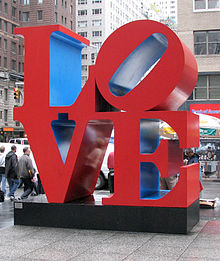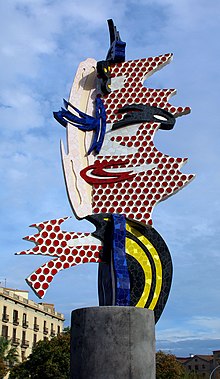Pop art
Pop Art is an art movement , particularly in painting and sculpture , that originated independently in Great Britain and the USA in the mid-1950s , and became a predominant form of artistic expression in North America and Europe in the 1960s .
The motifs are often taken from everyday culture, the world of consumption , the mass media and advertising, with the representation in photo-realistic and mostly oversized images.
definition
Pop Art is short for popular art - the name is attributed to the English art critic Lawrence Alloway - is often characterized as a reaction to the emphatically intellectual abstract art and turns to the trivial. The pop artist demands absolute reality, which means that all elements must be pure, clearly definable object elements. With some artists, the shapes are outlined with black lines, as in comic books. Often the objects shown are designed like in a poster without depth, i.e. flat. The colors are always clear, mostly only the achromatic and primary colors are used.
Two different basic attitudes can be identified within Pop Art: on the one hand, an initial enthusiasm for the (re) attained prosperity after the Second World War and the associated consumer society, on the other hand, a later critical attitude. This can be traced back to events such as the Vietnam War , the assassination of John F. Kennedy , race riots and the increasing drug use in the USA in the 1960s, as they showed the vulnerability of this seemingly perfect calculated affluent society.
Pop Art in Great Britain
Many art historians and critics consider Richard Hamilton to be the founder of Pop Art, although he refused to be called the "father of Pop Art" throughout his life. His work Just What Is It That Makes Today's Homes So Different, So Appealing? from 1956 (collage, today: Kunsthalle Tübingen ) is considered the first work of Pop Art that contained all typical ingredients. The work was used as a motif for the poster for the exhibition This is Tomorrow , which took place in 1956 at the Whitechapel Art Gallery in London. This exhibition was the last joint event of the Independent Group , a group formed by artist friends who discussed the phenomenon of the mass media and their relationship to contemporary art. At the same time, the group wanted to bring new topics closer to an interested public in an unusual form of presentation.
Eduardo Paolozzi , Peter Blake , David Hockney , Allen Jones , RB Kitaj , Peter Phillips and Pauline Boty were the other most important artists of English Pop Art.
Pop Art in the US and Europe
In the United States, Pop Art was understood as a deliberate departure from abstract expressionism painting . Due to the artistic tradition of the USA, Pop Art was more direct and less theoretical here than in Europe. Richard Lindner was an important pioneer . The flag pictures by Jasper Johns and the material objects by Robert Rauschenberg , which are considered the forerunners of Pop Art without belonging to this style, are very well known . Genuine Pop Art includes the screen prints by Andy Warhol and the comic pictures by Roy Lichtenstein , the object replicas made of soft materials by Claes Oldenburg and Coosje van Bruggen , the large-format pictures by James Rosenquist , the Love sculptures by Robert Indiana and the antiseptic bathroom scenes by Tom Wesselmann . Andy Warhol is considered to be the ultimate pop artist who represents pop as a person and as art. He and a number of other pop artists (Lichtenstein, Rosenquist, Wesselmann) came from the commercial art practice, which means no flaw in the capitalist USA. Warhol was already successful as a commercial artist and marketed his art even more successfully.
With the exhibition New Painting of Common Objects in 1962 in Pasadena at the Pasadena Museum of Art , Walter Hopps presented the first overview of the new American Pop Art in a museum. One of the last surviving representatives from the early days of American Pop Art is James Gill .
In Europe, American Pop Art was shown for the first time in 1964 in the exhibitions Amerikansk pop-konst at the Moderna Museet Stockholm, Copenhagen and Amsterdam and New Realists & Pop Art at the Gemeentemuseum Den Haag , Vienna, Berlin and Brussels, and on a larger scale in 1968 at the 4. documenta in Kassel. The collector Peter Ludwig acquired large blocks of works that were later donated to the Museum Ludwig in Cologne , where one of the largest collections of Pop Art outside the USA is still located today. At the end of the 1980s, extensive groups of works with works by Warhol, Lichtenstein, Jasper Johns and Rauschenberg were added to the holdings of the Museum of Modern Art in Frankfurt am Main from Karl Ströher's collection .
As an ironic variation on Pop, four Düsseldorf artists - Gerhard Richter , Sigmar Polke , Konrad Lueg and Manfred Kuttner - coined the term Capitalist Realism for their joint exhibition in an abandoned Düsseldorf shop (May 1963) . A few months later, Richter and Lueg organized a performance in a Düsseldorf furniture store under the title Leben mit Pop - a demonstration for capitalist realism (October 11, 1963). These two events are commonly seen as the birth of German pop .
The Berlin gallery owner René Block used the term capitalist realism to classify the artists KP Brehmer , Karl Horst Hödicke , Sigmar Polke and Wolf Vostell exhibited . They isolated banal everyday objects either alone or in collages as about Wolf Vostell in agen Dé-coll / and blurring or KP Brehmer in his Trivial graphics alienated and processed.
Rauschenberg, Johns, Hockney
Rauschenberg, Jasper Johns and Hockney are usually wrongly attributed to Pop Art. At best, they can be seen as their unwilling pioneers.
With his Combine Paintings , as the art critic Klaus Honnef writes, Robert Rauschenberg did not focus on the glamorous side of urban civilization, "but on the used and discarded" and gave it a "new pathetic dignity". In retrospect, they seem to have more in common with Abstract Expressionism than with Pop Art. Although his early work anticipated later Pop Art, “he never completely devoted himself to it”.
Jasper Johns said of himself “I'm not a pop artist!” And in fact - according to Klaus Honnef - he associates almost nothing with pop, although some of his painting Flag (the US American flag in encaustic ) from 1954/55 is considered was considered a "milestone on the way to Pop Art". He himself was concerned with the question of the difference between art and reality: Is a flag a painting or a flag? His answer: both; only the painterly treatment of the object reveals the difference.
Apart from a handful of works from his early days, David Hockney did not paint any outspoken pop pictures either.
Early Pop Art exhibitions
- 1956: Whitechapel Art Gallery , London: This Is Tomorrow , curated by Lawrence Alloway
- 1958: Leo Castelli Gallery , New York, Jasper Johns (first solo exhibition)
- 1958: Leo Castelli Gallery, New York, Robert Rauschenberg
- 1962: Sidney Janis Gallery , New York, The New Realists from the American side a. a. with Jim Dine, Robert Indiana, Roy Lichtenstein, Robert Moskowitz, Claes Oldenburg, James Rosenquist, George Segal, Andy Warhol and Tom Wesselmann. There are also many Nouveaux Realistes ; Stable Gallery, New York, Robert Indiana . Solo shows by all of NYC's leading artists.
- 1962: Leo Castelli Gallery, New York, Roy Lichtenstein
- 1963: Ileana Sonnabend Gallery , Paris, Roy Lichtenstein ; The Jewish Museum, New York, Robert Rauschenberg ; Solomon R. Guggenheim Museum , New York, Six Painters and The Object with Jim Dine, Jasper Johns, Roy Lichtenstein, Robert Rauschenberg, James Rosenquist and Andy Warhol
- 1964: February – April: Amerikansk pop-konst. Moderna Museet, Stockholm. Then in the Louisiana Museum of Modern Art (Humlebæk) and in the Stedelijk Museum (Amsterdam).
- 1964: Nieuwe Realisten , Gemeentemuseum Den Haag, then in the Vienna Community Museum, as New Realists & Pop Art in the Academy of Arts , Berlin. And in Brussels in the Palais des Beaux-Arts.
Important representatives
literature
- Ernst A. Busche: Roy Lichtenstein. The early work 1942–1960. Gebrüder Mann Verlag, 1988, ISBN 3-7861-1488-9 .
- Stephan Diederich, Luise Pilz (eds.): LUDWIG GOES POP (exhibition catalog German / English 2014/15 KÖLN, MUSEUM LUDWIG / WIEN, MUSEUM MODERNER KUNST STIFTUNG LUDWIG), bookstore Walther König, Cologne 2014.
- Walter Grasskamp , Michaela Krützen, Stephan Schmitt (Eds.): What is Pop? Ten attempts . Fischer, Frankfurt am Main 2004
- Richard Hamilton: Retrospective / Introspective: Retrospective. Paintings and drawings from 1937 to 2002. Volume 1, W. König, Cologne 2003, ISBN 3-88375-657-1 .
- Werner Hofmann: New Realists & Pop Art. Exhibition catalog. Academy of Arts, Berlin 1964.
- Klaus Honnef : Andy Warhol, 1928–1987. Art as Commerce , Taschen, Cologne 1999, ISBN 3-8228-6378-5 .
- Klaus Honnef, Uta Grosenick (eds.): Pop Art. Taschen, Cologne 2004, ISBN 3-8228-2216-7 . (New edition: 2015, ISBN 978-3-8365-0599-4 ).
- Tobias Lander: The world of things of Pop Art. Imhof, Petersberg 2012, ISBN 978-3-86568-135-5 .
- Lucy R. Lippard (Ed.): Pop Art. New York.
- Tilman Osterwold: Pop Art. Taschen, Cologne 2007, ISBN 978-3-8228-3753-5 .
- Heinz Ohff: Pop and the Consequences or The Art of Finding Art on the Street. Visualized by Wolf Vostell. Droste, Düsseldorf 1968
- Robert Rauschenberg, Trisha Brown a. a .: Robert Rauschenberg. Hatje Cantz, 1998, ISBN 3-7757-0750-6 .
Web links
- Heiko Klaas, Nicole Büsing: Don't forget your shopping bag! To the Andy Warhol exhibition in Berlin. In: spiegel.de
- Pop art icon Robert Rauschenberg is dead. In: Der Spiegel. May 13, 2008.
Individual evidence
- ↑ Klaus Honnef , Uta Grosenick (ed.): Pop Art. Taschen, Cologne 2015, ISBN 978-3-8365-0599-4 , p. 7.
- ↑ Alexander Menden: The power of filtered images. On the death of the British artist Richard Hamilton, who never wanted to be the 'father of Pop Art'. In: Süddeutsche Zeitung. September 15, 2011, p. 15.
- ↑ Uwe M. Schneede: The history of art in the 20th century: From the avant-garde to the present. CH Beck, Munich 2001, ISBN 3-406-48197-3 .
- ↑ Alice Rawsthorn: Tomorrow's girl. In: The guardian . June 19, 2004.
- ↑ Klaus Honnef: Pop Art. Taschen, Cologne 2015, p. 28.
- ↑ Klaus Honnef: Pop Art. Taschen, Cologne 2015, p. 22.
- ↑ "Art as Commerce" is the subtitle of Klaus Honnef's monograph on Warhol. See Klaus Honnef: Warhol 1928–1987. Art as commerce. Taschen, Cologne 2006.
- ↑ Dieter Honisch, Jens Christian Jensen and others: American art from 1945 to today: Art of the USA in European collections. DuMont, Cologne, 1976, ISBN 3-7701-0914-7 .
- ↑ DuMont's glossary of terms on contemporary art. DuMont, Cologne 2002, p. 248.
- ^ Sighard Neckel (Ed.): Capitalist Realism. From the art action to social criticism . Campus, Frankfurt am Main 2010, ISBN 978-3-593-39182-3 , pp. 11-14.
- ↑ Klaus Honnef: Pop Art. Taschen, Cologne 2015, p. 68.
- ↑ Hans Pietsch: There were no limits for him. In: Art. The art magazine. December 2016, p. 111.
- ↑ Klaus Honnef: Pop Art. Taschen, Cologne 2015, p. 24.
- ↑ Klaus Honnef: Pop Art. Taschen, Cologne 2015, p. 24 u. 46.
- ↑ Klaus Honnef: Pop Art. Taschen, Cologne 2015, p. 21.
- ↑ Chronology of Pop Art at Center Pompidou . Alloway coined the new term Pop Art
- ^ Alfred Berr bought four pictures from the exhibition for the Museum of Modern Art
- ↑ Rauschenberg exhibits, among other things, the paintings and objects Bed (object collage, painted, 1955), Rebus (oil on canvas, 1955) and Interview (object collage, painted, 1955).

